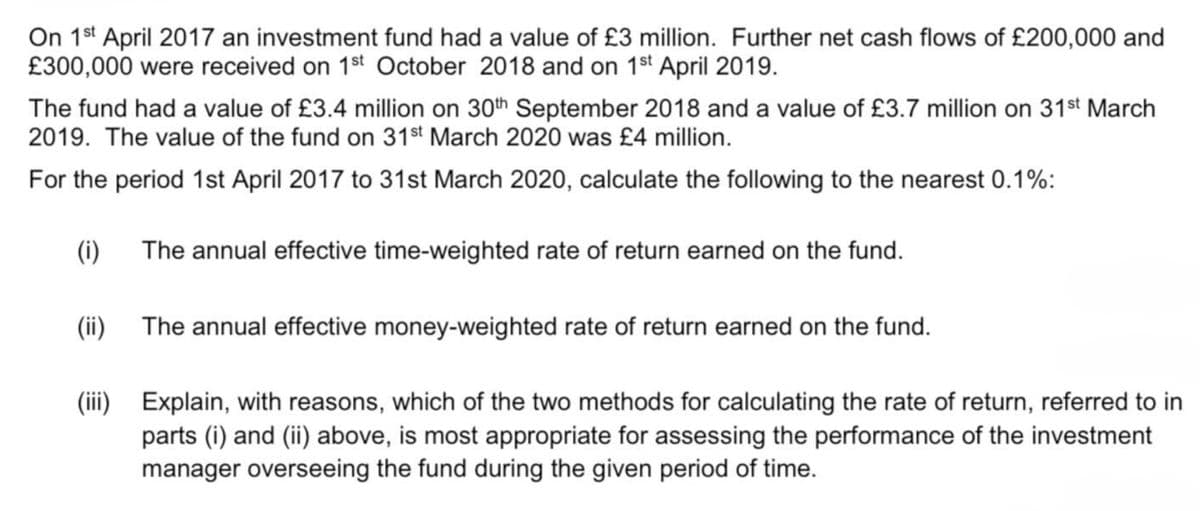On 1st April 2017 an investment fund had a value of £3 million. Further net cash flows of £200,000 and £300,000 were received on 1st October 2018 and on 1st April 2019. The fund had a value of £3.4 million on 30th September 2018 and a value of £3.7 million on 31st March 2019. The value of the fund on 31st March 2020 was £4 million. For the period 1st April 2017 to 31st March 2020, calculate the following to the nearest 0.1%: The annual effective time-weighted rate of return earned on the fund. (i) The annual effective money-weighted rate of return earned on the fund. (iii) Explain, with reasons, which of the two methods for calculating the rate of return, referred to in parts (i) and (ii) above, is most appropriate for assessing the performance of the investment manager overseeing the fund during the given period of time. (ii)
On 1st April 2017 an investment fund had a value of £3 million. Further net cash flows of £200,000 and £300,000 were received on 1st October 2018 and on 1st April 2019. The fund had a value of £3.4 million on 30th September 2018 and a value of £3.7 million on 31st March 2019. The value of the fund on 31st March 2020 was £4 million. For the period 1st April 2017 to 31st March 2020, calculate the following to the nearest 0.1%: The annual effective time-weighted rate of return earned on the fund. (i) The annual effective money-weighted rate of return earned on the fund. (iii) Explain, with reasons, which of the two methods for calculating the rate of return, referred to in parts (i) and (ii) above, is most appropriate for assessing the performance of the investment manager overseeing the fund during the given period of time. (ii)
Intermediate Accounting: Reporting And Analysis
3rd Edition
ISBN:9781337788281
Author:James M. Wahlen, Jefferson P. Jones, Donald Pagach
Publisher:James M. Wahlen, Jefferson P. Jones, Donald Pagach
ChapterM: Time Value Of Money Module
Section: Chapter Questions
Problem 10RE: If 90,000 is invested in a fund on December 31, 2019, and 5 equal annual withdrawals of 23,138.32...
Related questions
Question
Using formulas, no tables
correct answers:
i) 0.052169 pa
ii) let NFV(5%)= 0.003061 and let NFV(4%)= -0.101289, Then i = 0.0497 pa

Transcribed Image Text:On 1st April 2017 an investment fund had a value of £3 million. Further net cash flows of £200,000 and
£300,000 were received on 1st October 2018 and on 1st April 2019.
The fund had a value of £3.4 million on 30th September 2018 and a value of £3.7 million on 31st March
2019. The value of the fund on 31st March 2020 was £4 million.
For the period 1st April 2017 to 31st March 2020, calculate the following to the nearest 0.1%:
(i)
(ii)
The annual effective time-weighted rate of return earned on the fund.
The annual effective money-weighted rate of return earned on the fund.
(iii) Explain, with reasons, which of the two methods for calculating the rate of return, referred to in
parts (i) and (ii) above, is most appropriate for assessing the performance of the investment
manager overseeing the fund during the given period of time.
Expert Solution
This question has been solved!
Explore an expertly crafted, step-by-step solution for a thorough understanding of key concepts.
Step by step
Solved in 5 steps with 7 images

Recommended textbooks for you

Intermediate Accounting: Reporting And Analysis
Accounting
ISBN:
9781337788281
Author:
James M. Wahlen, Jefferson P. Jones, Donald Pagach
Publisher:
Cengage Learning

Intermediate Accounting: Reporting And Analysis
Accounting
ISBN:
9781337788281
Author:
James M. Wahlen, Jefferson P. Jones, Donald Pagach
Publisher:
Cengage Learning